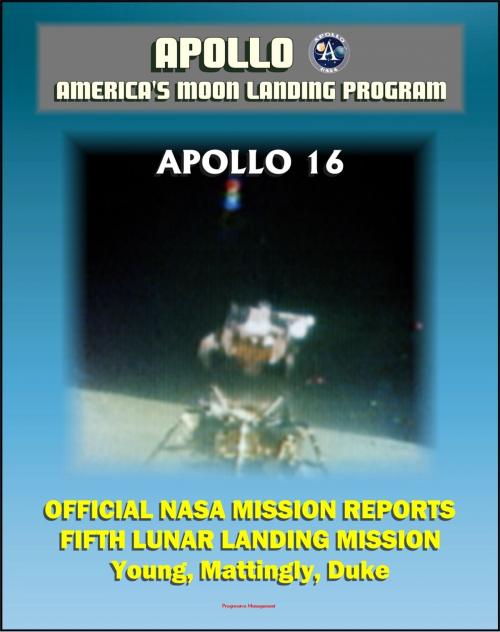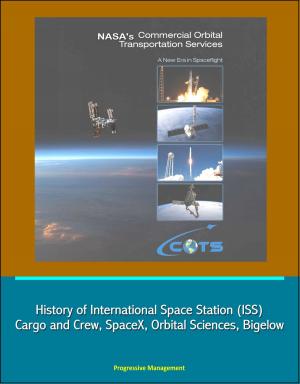Apollo and America's Moon Landing Program: Apollo 16 Official NASA Mission Reports and Press Kit - 1972 Fifth Lunar Landing at Descartes - Astronauts Young, Mattingly, and Duke
Nonfiction, Science & Nature, Science, Physics, Astronomy, History, Americas| Author: | Progressive Management | ISBN: | 9781466158153 |
| Publisher: | Progressive Management | Publication: | December 3, 2011 |
| Imprint: | Smashwords Edition | Language: | English |
| Author: | Progressive Management |
| ISBN: | 9781466158153 |
| Publisher: | Progressive Management |
| Publication: | December 3, 2011 |
| Imprint: | Smashwords Edition |
| Language: | English |
Three comprehensive official NASA documents - converted for accurate flowing-text ebook format reproduction - chronicle the flight of Apollo 16, which landed at Descartes in 1972.
Two technical mission reports, the Manned Spacecraft Center (MSC) Apollo Mission Report and the NASA Headquarters Mission Operation Report (MOR), provide complete details about every aspect of the mission.
Apollo 16 MSC Mission Report: Mission description, pilots' report, communications, trajectory, command and service module performance, mission support performance, assessment of mission objectives, launch vehicle summary, anomaly summary (CSM, LM, government furnished equipment), conclusions, vehicle descriptions. Apollo 16 MOR: Mission design and execution, spacecraft performance, flight anomalies, detailed objectives and experiments, launch countdown, detailed flight mission description, back contamination program, contingency operations, configuration differences, mission support, recovery support plan, flight crew, mission management responsibility, program management, abbreviations and acronyms. Apollo 16 Press Kit: Detailed preview from countdown to landing.
Apollo 16 lifted off at 12:54 p.m. EST April 16, 1972, from Launch Complex 39 at Kennedy Space Center in Florida. Two significant command and service module problems – one en route to the moon and one in lunar orbit – contributed to a delay in landing and a subsequent early termination of the mission by one day. An erroneous signal indicating guidance system gimbal lock during translunar coast was neutralized by real time programming change instructing the spacecraft computer to ignore input. After undocking of Casper and Orion, circularization burn of the CSM was delayed when backup circuit caused yaw oscillations of service propulsion system. Orion landing was held until engineers determined oscillations would not seriously affect CSM steering.
Lunar module, or LM, carrying John Young and Charles Duke touched down at Descartes about 276 meters northwest of planned point (8 degrees 59’ 29”S, 15 degrees 30’ 52”E) at about 9:24 p.m. EST April 20, about five hours, 43 minutes late. During 71 hours, two minutes surface stay, astronauts explored region on three EVAs totaling 20 hours, 14 minutes. First EVA included Lunar Roving Vehicle setup and ALSEP deployment. Heat flow experiment was lost when Young tripped on electronics cable, breaking it. Rover traverse took astronauts west to Flag Crater where they collected samples and photographed the area. Return drive was south of outbound track to Spook Crater where astronauts took first measurement with the lunar portable magnetometer, gathered samples, and took both panoramic and 500 mm telephotography. Just before returning to the lunar module, they deployed the solar wind composition experiment at the ALSEP site. EVA duration was about seven hours, 11 minutes with 2.5 miles driven in the rover.
Second EVA began with drive south to Stone Mountain, where surface and core samples were collected at two stations in the area of Cinco Craters, along with a trench sample, penetrometer measurements and photography. Traverse continued west, then north with stops at five additional stations for similar work. One station was deleted from the EVA plan because of time factors. Lunar portable magnetometer, or LPM, measurements were taken near Cinco. Crew returned to lunar module and ended second EVA after seven hours, 23 minutes and 6.9 miles on the rover.
Three comprehensive official NASA documents - converted for accurate flowing-text ebook format reproduction - chronicle the flight of Apollo 16, which landed at Descartes in 1972.
Two technical mission reports, the Manned Spacecraft Center (MSC) Apollo Mission Report and the NASA Headquarters Mission Operation Report (MOR), provide complete details about every aspect of the mission.
Apollo 16 MSC Mission Report: Mission description, pilots' report, communications, trajectory, command and service module performance, mission support performance, assessment of mission objectives, launch vehicle summary, anomaly summary (CSM, LM, government furnished equipment), conclusions, vehicle descriptions. Apollo 16 MOR: Mission design and execution, spacecraft performance, flight anomalies, detailed objectives and experiments, launch countdown, detailed flight mission description, back contamination program, contingency operations, configuration differences, mission support, recovery support plan, flight crew, mission management responsibility, program management, abbreviations and acronyms. Apollo 16 Press Kit: Detailed preview from countdown to landing.
Apollo 16 lifted off at 12:54 p.m. EST April 16, 1972, from Launch Complex 39 at Kennedy Space Center in Florida. Two significant command and service module problems – one en route to the moon and one in lunar orbit – contributed to a delay in landing and a subsequent early termination of the mission by one day. An erroneous signal indicating guidance system gimbal lock during translunar coast was neutralized by real time programming change instructing the spacecraft computer to ignore input. After undocking of Casper and Orion, circularization burn of the CSM was delayed when backup circuit caused yaw oscillations of service propulsion system. Orion landing was held until engineers determined oscillations would not seriously affect CSM steering.
Lunar module, or LM, carrying John Young and Charles Duke touched down at Descartes about 276 meters northwest of planned point (8 degrees 59’ 29”S, 15 degrees 30’ 52”E) at about 9:24 p.m. EST April 20, about five hours, 43 minutes late. During 71 hours, two minutes surface stay, astronauts explored region on three EVAs totaling 20 hours, 14 minutes. First EVA included Lunar Roving Vehicle setup and ALSEP deployment. Heat flow experiment was lost when Young tripped on electronics cable, breaking it. Rover traverse took astronauts west to Flag Crater where they collected samples and photographed the area. Return drive was south of outbound track to Spook Crater where astronauts took first measurement with the lunar portable magnetometer, gathered samples, and took both panoramic and 500 mm telephotography. Just before returning to the lunar module, they deployed the solar wind composition experiment at the ALSEP site. EVA duration was about seven hours, 11 minutes with 2.5 miles driven in the rover.
Second EVA began with drive south to Stone Mountain, where surface and core samples were collected at two stations in the area of Cinco Craters, along with a trench sample, penetrometer measurements and photography. Traverse continued west, then north with stops at five additional stations for similar work. One station was deleted from the EVA plan because of time factors. Lunar portable magnetometer, or LPM, measurements were taken near Cinco. Crew returned to lunar module and ended second EVA after seven hours, 23 minutes and 6.9 miles on the rover.















